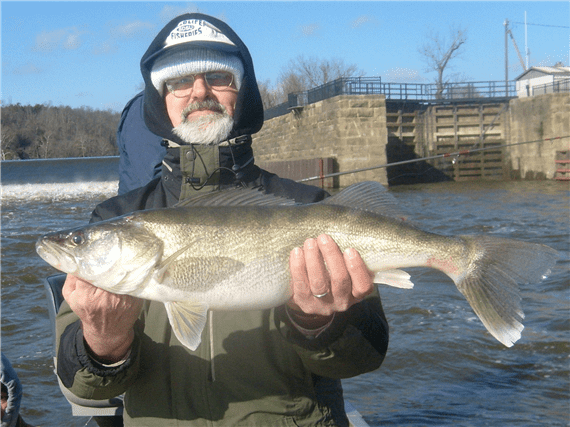Netting Ice-out Walleye
Dan Armitage 03.31.14

Walleye anglers cross the Midwest have a break about now each season, when conditions are usually too iffy for ice fishing and open water is still a few weeks out. With winter not willing to release its icy grip this season, the annual ice-out fishery is delayed a bit, but it’s coming. In fact, across the walleye’s southern range, it may already have arrived.
That leaves just about enough time to trade in the sleds, shanties, and short sticks for traditional tackle and a boat that can take a bit of a beating before a fishing phenomenon takes place that offers the largest walleye of the season. Named for the annual break-up across the North Country that heralds the spring to come, ice-out fishing for walleye is a ritual for those who know the payoff for braving the bitter conditions: fat, egg-laden walleye staging for the spawn. The fish are often stacked at river headwaters, off rocky shorelines and over shallow, mid-lake reefs, concentrating the action for the anglers who know how to locate the pre-spawn fish and how to fool them once found.
It’s an early spring sport that Sam Anderson learned from his walleye-fishing father, who got the boy started walleye fishing early in life and early each spring in their home waters around St. Paul, Minnesota. The younger Anderson got good enough at catching walleyes to hold his own in local tournaments, and has spent considerable time as a professional angler competing in the major walleye circuits.
No matter where he finds himself across walleye country this time each year, Anderson’s fishing season begins about now. When waters start to inch their way above the 35-degree mark and ice breaks up on local lakes and rivers, he’s geared-up and ready to tackle waters that may offer everything from shore ice to full-size ‘bergs bigger than his boat. He is often joined by anglers who fish from open aluminum boats light enough to be pushed across shore ice to reach open water and realize the risk is worth the reward.
While there are some shore opportunities for ice-out walleye fishing, by its very nature the early season action usually takes place on newly-opened water that is still surrounded by shore ice, limiting the chances for land-bound fishermen to get within casting range of the fish. The exception, says Anderson, is along rip-rap or sandy beaches and shorelines, especially those found on the north side of lakes or bays where structure—and the water it helps warm—receives the full benefit of the lengthening spring sunlight.
For the most part, in lakes or rivers, ice-out fishing for walleye is done from boats. This time of year, Anderson loads his boat with spinning rods measuring six- to six-and-a-half feet long with reels spooled with six-pound-test Fireline. If the water is clear, he’ll use a nail knot to attach a monofilament leader of the same breaking strength; usually, says Anderson, pre-spawn waters have enough color to allow him to knot his lures direction to the low-stretch superbraid.
“Superbraid line is important,” he explained, “because it allows you to stay in much better touch with the bait. You can detect light bites and potential snags—and move the bait away before you hang-up.”
Which is easy to do with one of the two primary baits he recommends for ice-out fishing: lead-headed jigs trimmed with hair or twister tails, often tipped with minnows or worms. He matches the size of his baits to that of the local walleye population; he uses plastic tails, hair, minnows, or worms measuring two inches for most of his pre-spawn jig fishing. When dredging depths known to hold big walleyes, he’ll move up to baits offering three-inch profiles. That said, he advises that anglers fishing the pre-spawn not focus all their attention on the bottom.
“Especially if the water is dirty, I’ll fish for walleyes suspended in the water column,” said Anderson, who casts jigs or uses a spinner behind a bottom bouncer to locate pockets of active fish in muddy water.
“Live-bait rigs and spinners will fool fish when nothing else will,” he continued, “for several reasons. They allow an angler to present a bait to the fish in a very natural, lifelike manner using nothing more than a hook, snell, and sinker. In some circumstances a colored bead can be added like a Stealth Rig, with an adjustable sinker, or a spinner, like the Lindy Spinning Rig, or a float like a Lindy Floating Rig which makes the bait ride higher off the bottom. All are simple, natural and super effective for pre-spawn fish.”
Whether using jig or spinner rigs, in water clear or stained, Anderson keeps track of the size of the walleyes he is catching.
“If I start catching all small fish, which are usually males, I’ll move deeper—often to water 20 to 35 feet down. That means the spawn has taken place, the males have moved in, and the females have moved off the shallows into deep adjacent water to feed.”
That move triggers a change in tactics required to catch the walleyes—and the closing of a window of opportunity for big, egg-laden females.

